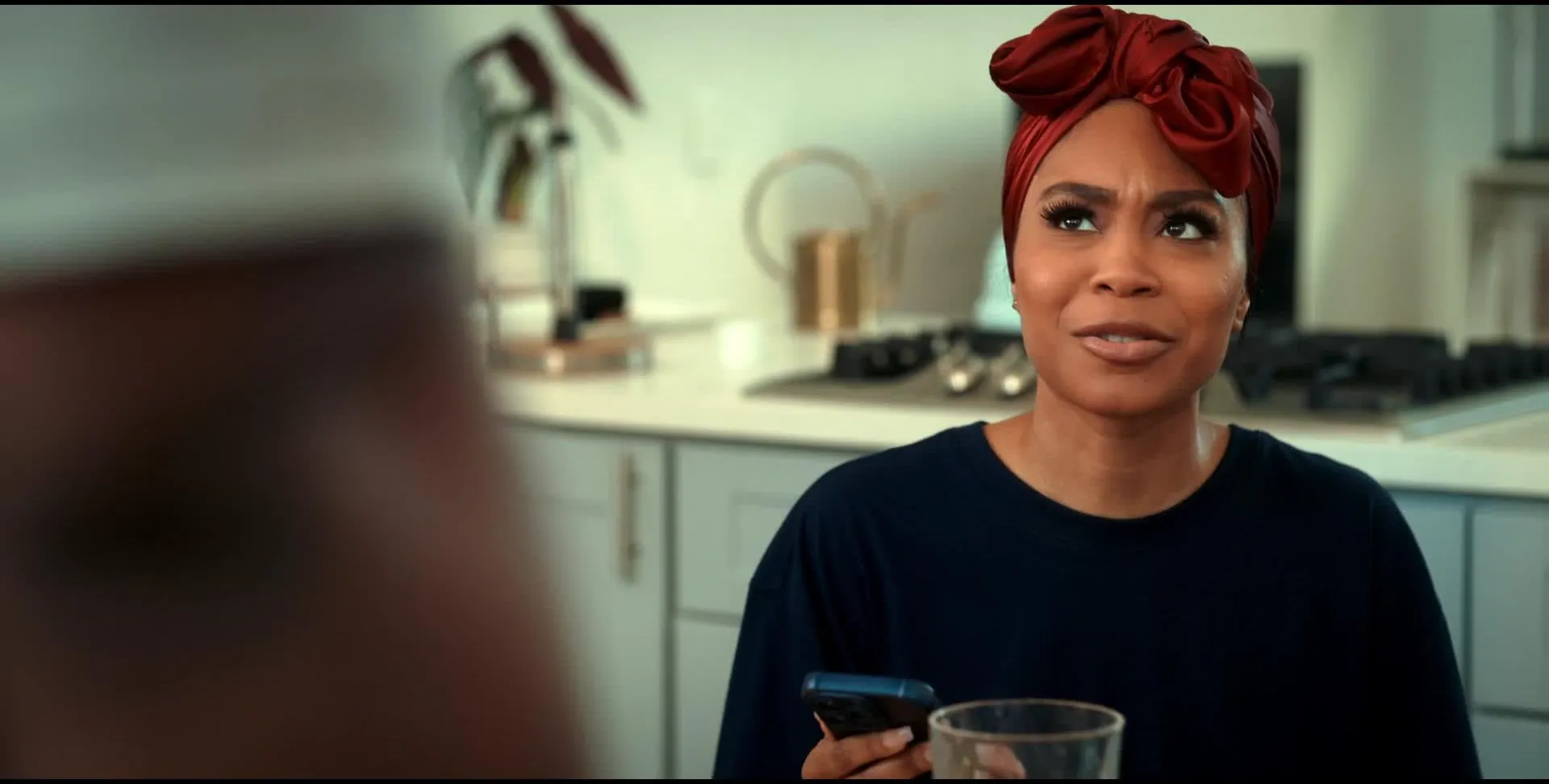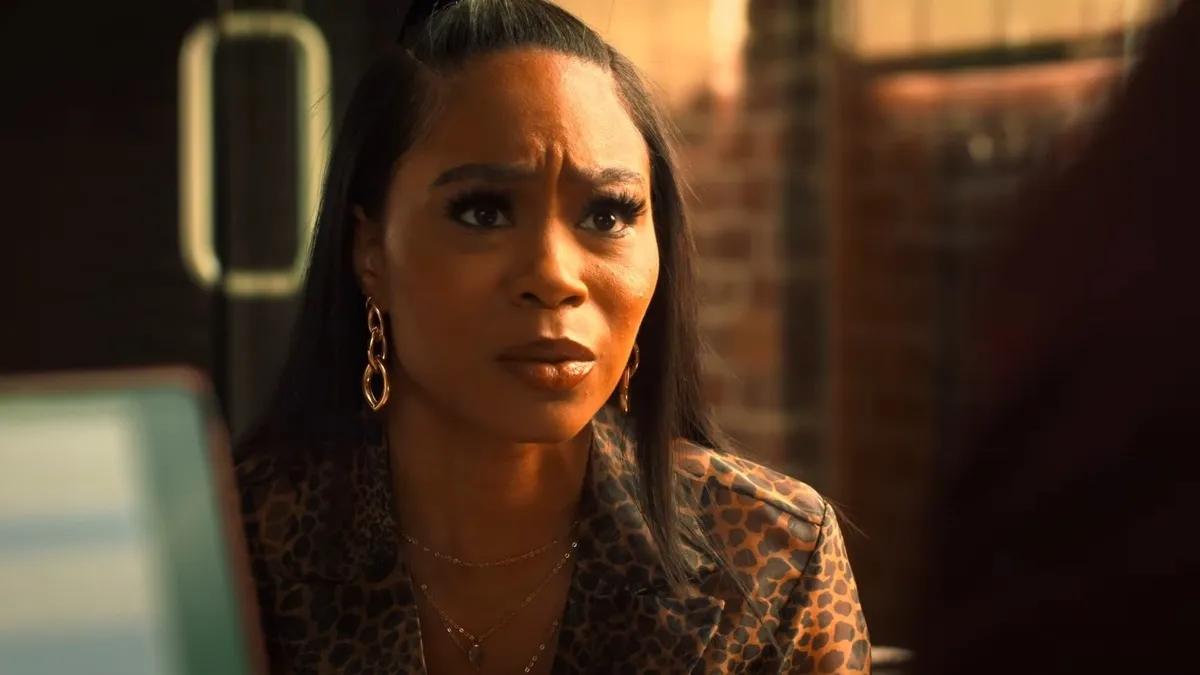Toxic Harmony presents a familiar story of ambition and exploitation in the music industry. Constance, an aspiring singer, seeks to enter the business with her well-meaning but ineffective boyfriend-manager, Lucas. This introduces her to Tyree and J-Money, two label executives who promise her a chance at success.
As Constance delves deeper into the industry, the darker aspects of Arbor Way Records surface, exposing underlying corruption and manipulation. The plot races through these developments, providing minimal suspense or surprise. The final segment feels rushed, with multiple murders occurring quickly but lacking the necessary build-up or emotional depth to create impact.
The narrative lacks originality—events unfold exactly as the audience anticipates. The story follows a traditional path, avoiding risks and missing opportunities for a more compelling exploration of its themes. The film’s conventional approach results in a predictable and unsatisfying conclusion.
Character Development and Performances
Constance, an aspiring singer, ventures into the challenging world of the music industry. Her path is marked by compromise—confronting the brutal landscape of fame, she gradually erodes her artistic principles in pursuit of recognition.
Ashley Love-Mills portrays Constance with a powerful, layered performance, blending her character’s fragility with moments of wit and resilience. She creates a magnetic screen presence, elevating Constance beyond the typical naive newcomer archetype. Love-Mills infuses the character with raw intensity, anchoring her journey with emotional authenticity.
The supporting cast appears more like narrative devices than fully realized characters. Lucas, Constance’s boyfriend-manager, emerges as an ineffective supporter. His struggles with industry dynamics intensify Constance’s challenges, yet his personal trajectory remains unexplored.
Tyree and J-Money, music executives manipulating Constance, symbolize the industry’s shadowy underbelly. Their sparse backstories prevent them from becoming multidimensional antagonists. Darla, a former artist turned addict who attempts to warn Constance, represents another underdeveloped character. Her tragic history, intended as a warning, feels disconnected—her cautionary message lacks emotional weight due to limited character development.
The interaction between Constance and Tyree provides glimpses of compelling dramatic potential. Their relationship, charged with professional ambition and romantic tension, hints at deeper narrative possibilities. Regrettably, this dynamic remains superficial—similar to Constance’s connection with V Shaw, which could have offere
Themes and Social Commentary
Toxic Harmony explores the treacherous landscape of artistic ambition and industry manipulation. Constance’s path to recognition happens quickly, carrying a significant emotional toll.
She sacrifices her artistic vision for momentary fame, revealing the music industry’s predatory mechanisms. The narrative exposes the challenging environment for female artists, connecting to broader discussions about power structures and exploitation.
The film’s underlying themes echo recent cultural conversations about systemic misconduct. Music executives Tyree and J-Money represent manipulative forces, mirroring real-world scandals exposed by activist movements.
Their interactions with Constance reflect patterns of control and abuse prevalent in entertainment circles. While the film references broader social issues, its treatment remains somewhat generic, stopping short of deep analytical insights.
Darla, a former artist struggling with addiction, appears as a potential warning symbol. Her character offers glimpses into the industry’s destructive patterns.
Regrettably, her narrative remains incomplete—her backstory and significance are barely touched, leaving her role feeling peripheral and underdeveloped. The film gestures toward critical commentary without fully excavating the systemic challenges facing young artists.
Direction and Cinematography
Kevin Arbouet’s direction of Toxic Harmony feels serviceable but uninspired. The film struggles to generate meaningful suspense or dramatic intensity.
Arbouet follows standard genre conventions without introducing creative elements that might energize the narrative. His approach remains conservative, missing opportunities to explore the psychological landscape of the music industry’s darker side.
Specific moments reveal glimpses of directorial potential. A time-lapse sequence showing Constance collapsing onto a couch captures her emotional and physical deterioration with striking visual language. This brief scene stands out as a rare moment of creative risk-taking, using visual technique to communicate character experience beyond traditional storytelling methods.
The film’s visual approach ultimately feels pedestrian. Cinematography and lighting remain functional without adding emotional depth or atmospheric complexity. Despite the inherently dramatic world of the music business, the visual style remains muted and conventional. Opportunities to contrast external glamour with internal corruption go unexplored, leaving the film’s visual language as unremarkable as its narrative approach.
Music and Sound Design
Music in Toxic Harmony attempts to establish the film’s industrial backdrop, yet falls short of creating meaningful atmosphere. The soundtrack emerges as a generic collection of forgettable tracks that fail to capture the music world’s complexity.
Pop songs play without purpose, serving as background noise rather than narrative support. These selections lack depth, representing the industry’s superficial nature without genuine artistic exploration.
Musical performances featuring Constance appear stilted and artificial. Excessive audio manipulation through autotune strips away her character’s emotional authenticity.
The processed vocals create emotional distance, undermining the story’s core themes of artistic integrity and personal struggle. What could have been raw, powerful moments become sterile and manufactured representations of musical expression.
Sound design remains passive throughout the film. Sonic elements miss opportunities to build tension or communicate psychological nuance.
The audio landscape feels perfunctory—technical without creativity, functional without feeling. Potential to explore the music industry’s intricate emotional terrain goes unexplored, leaving the film’s sensory experience flat and unengaging.
Tone and Genre
Toxic Harmony struggles to establish itself within the thriller genre. The film introduces dark themes of music industry exploitation but fails to generate meaningful narrative tension.
Plot developments feel predictable, stripping away potential emotional impact. Each scene moves without creating genuine suspense or psychological depth.
Dramatic elements appear superficial and unconvincing. The story attempts to explore systemic manipulation of female artists, yet melodramatic approaches undermine serious subject matter. Tonal shifts between serious commentary and dramatic storytelling create an unbalanced narrative experience. The film’s exploration of industry corruption remains shallow and unconvincing.
Compared to similar genre films, Toxic Harmony lacks distinctive qualities. The narrative misses opportunities to shock or emotionally engage viewers. Without clear artistic vision, the film feels forgettable—a generic exploration of music industry challenges that fails to leave a lasting impression.
Pacing and Editing
Toxic Harmony suffers from severe pacing problems. The initial segments crawl, filled with unnecessary scenes that drain narrative energy.
Constance’s trajectory through the music industry lacks tension or engagement. Moments that could explore psychological impacts of artistic manipulation remain underdeveloped, replaced by tedious storytelling that struggles to maintain viewer interest.
The film’s climax arrives abruptly and without impact. Shocking events—multiple murders—happen in rapid succession, devoid of emotional context. These plot twists feel manufactured, failing to generate genuine dramatic weight. Narrative threads collapse under weak storytelling, leaving audiences disconnected from character experiences.
Editing compounds the film’s structural weaknesses. Scene transitions appear chaotic and disjointed, interrupting narrative flow. Sudden shifts between plot points prevent meaningful audience connection. The visual storytelling feels fragmented, creating a disorienting viewing experience that undermines any potential dramatic momentum.
The Review
Toxic Harmony
Toxic Harmony struggles to deliver on its thriller premise, faltering in both pacing and narrative depth. While the film touches on relevant themes of exploitation and ambition, it fails to execute them in a way that resonates or creates tension. The performances are solid, but the lack of a compelling plot and the rushed climax make it difficult to fully engage with the story. Ultimately, Toxic Harmony falls short of its potential, feeling more like a missed opportunity than a memorable thriller.
PROS
- Solid performances, particularly from Ashley Love-Mills as Constance.
CONS
- Slow pacing and a rushed, unsatisfying climax.
- Sloppy editing and transitions that disrupt the narrative flow.
- Missed opportunity for deeper exploration of its themes.
- Lack of suspense and a predictable plot.





















































